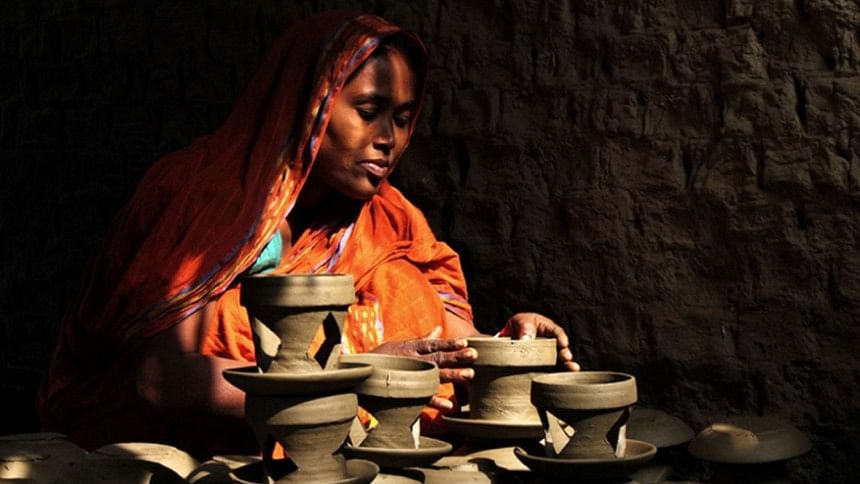How vulnerable are the small businesses?

In Bangladesh, the Covid-19 pandemic hit economic players all at once. The small business sector, the country's engine of growth and employment, is one of the worst-hit sectors because of its high dependency on low-skilled labour, low compliance with occupational health and safety standards, and limited access to the financial market. In late April 2020, LightCastle Partners & Sheba.xyz and Bangladesh Institute of Development Studies (BIDS) conducted a survey on the Small and Medium Enterprises (SME) and their workers and found that the pandemic-induced lockdown and social distancing caused a sharp contraction in production, supply chain disruption and workers' layoff, and that the SMEs needed financial support (e.g. loan) to get back on their feet. Now that the economy has opened up, are the SMEs recovering from that shock?
To understand the effects of lockdown and subsequent reopening of the economy on small enterprises and their workers, the BRAC Institute of Governance and Development (BIGD) in collaboration with Monash University, Australia, surveyed around 2,000 firms from 18 districts in Bangladesh in July. Of them, 95 percent are light engineering firms and the rest are other small businesses like beauty parlour, hotel, grocery store, and clothing/tailoring. The study mostly focused on the light engineering sector (a small and informal sector) which accounts for more than two million workers and 2 percent of the GDP.
During the lockdown, the majority of the small enterprises were shut down. After the lockdown was lifted, very few were still closed; about two-thirds were operating at full capacity while one-third were operating at a limited capacity.
After reopening, these enterprises were facing two-fold challenges: reduced demand and the burden of paying for fixed costs such as rent and utilities. Even after more than a month of reopening, almost all the enterprises were still running at the break-even point (very low average profit of Tk 4,000), largely due to the low volume of sales. The enterprises such as beauty parlour, hotel, and tailoring were facing the most severe drop in sales, reflecting the additional challenge of the service sector where social distancing is often not feasible.
Intriguingly, compared to the lockdown period, more owners were unable to pay the rent for their workshop premises after reopening. This is perhaps because the owners were in critical shortages of funds as the pandemic prolonged, and they used up their savings or, even worse, capital by then. Now, with low sales after reopening, they are struggling to meet the pressure of fixed costs. Predictably, those who were facing a larger drop in sales were more likely to face difficulty paying rent in July.
What made the situation worse, almost two-thirds of these enterprises also reported experiencing a shortage of raw materials. Most of them reported that they were either reducing their production or increasing product prices to cope with this shortage, further deepening the crisis.
Consequently, many workers of the small businesses were forced to leave jobs and migrated back to villages from towns and cities. Though most workers returned to work by July, income-recovery has been low for them. Male workers were earning about 30 percent less than the pre-pandemic period; female workers were earning 52 percent less. Female workers in these enterprises were also less likely to return to the labour market.
What's most concerning is that "poorer" enterprises, which had lower financial capital during the pre-pandemic period, are less likely to operate their business at full capacity after the end of the lockdown. They also had lower sales after the lockdown was lifted—the poorest enterprises were experiencing about 50 percent reduction in sales, almost double the loss incurred by the richest. These findings demonstrate the vulnerability of the poorer enterprises and the need for providing support for them to start their activities.
It is clear that the small businesses are in dire need of support to get back on their feet. On April 13, the government announced a stimulus package for SMEs through low-interest loans (about half of the market rates) to be delivered through the banking system. Though two-thirds of the surveyed enterprises reported that they knew about this initiative, only three percent applied for the support. Only one out of 1,960 firms received credit from the banking channel under the stimulus package of the government.
Our study found that the enterprises that had a higher profit margin before the pandemic were open during the lockdown, or had higher sales after the lockdown, or in other words, financially stronger enterprises were more likely to apply for government support. High costs in lending to the small enterprises and fear of non-repayment have already been established as major hindrances for small enterprises to access the incentive loans, and there is a growing concern that the stimulus package will not reach the vulnerable firms.
The targeting criteria for reaching the more vulnerable enterprises with the support package are of utmost importance. At the beginning of the pandemic, many experts had suggested that smaller enterprises should get priority for getting support. The small enterprises face several challenges in accessing credit through the formal banking system, and many of them are not even aware that they can obtain this support to recover from the shock created by the pandemic. When asked about their future business plan, almost half of these enterprises reported that they face uncertainties and could not make any plan for their business recovery. If the small businesses do not get support, many may never recover.
Apart from financial support, what factors can help small businesses be more resilient, particularly during a public health crisis like this? Before the pandemic hit the country, in 2017/18, BRAC provided intensive training on occupational health and safety (OHS) along with business training and financial linkages to a group of managers/owners of small firms. Our study found that in July, these SMEs made almost double the profit compared to the enterprises which did not receive the training; however, the absolute amounts of profit of both the training recipient and non-recipient enterprises were significantly low compared to their pre-pandemic profit. The findings indicate that OHS and business training can help firms survive in difficult times, and firms receiving such training are better able to withstand shocks like the ongoing pandemic.
It is evident that poorer enterprises and vulnerable workers (e.g. female workers) in the informal sector are experiencing severe challenges in coping with this "new normal". To ensure an equitable post-pandemic economic recovery, it is essential to increase the scope of the incentive and, more importantly, better target those who need it the most.
Asad Islam is Director, Centre for Development Economics and Sustainability (CDES), and a professor of economics at Monash University, Australia.
Atiya Rahman is Senior Research Associate, BRAC Institute of Governance and Development (BIGD), BRAC University.

 For all latest news, follow The Daily Star's Google News channel.
For all latest news, follow The Daily Star's Google News channel. 



Comments